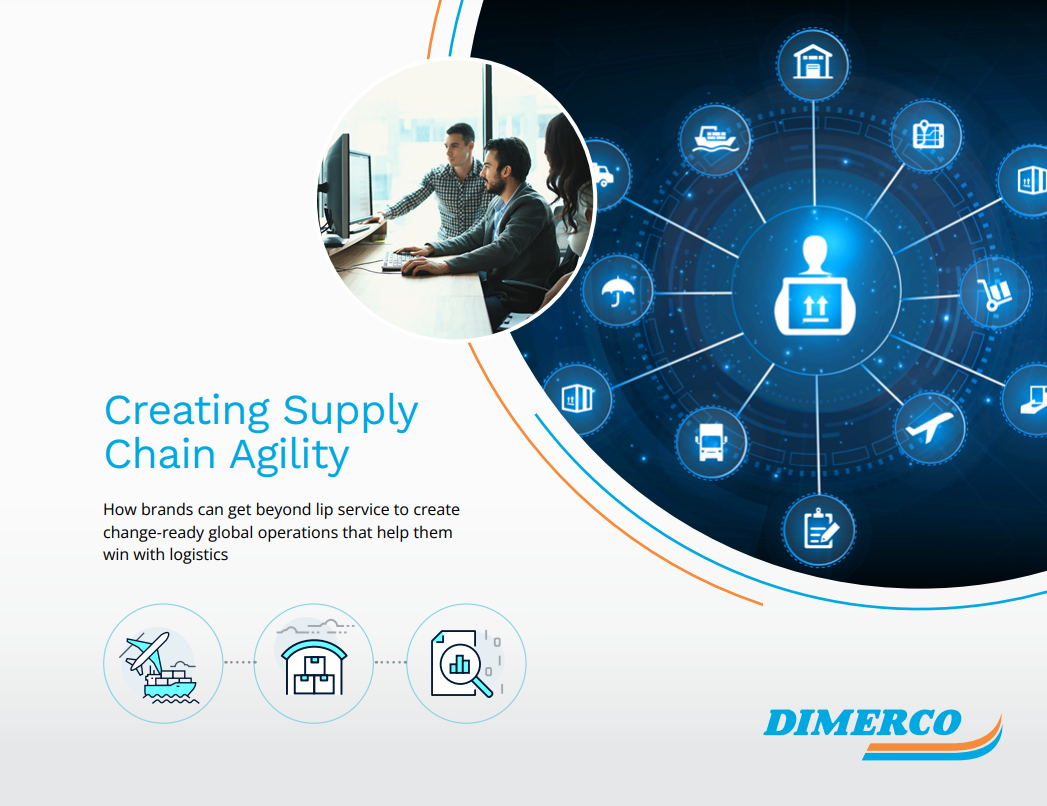Home »
Creating Supply Chain Agility
Contents
Logistics Agility
Preparing To Be Agile
Optimize Supply Chain Network
Build Better Supply Chain Systems
- Enhanced Visibility & Transparency
- Real-Time Collaboration
- Improved Decision-Making
- Enhanced Resilience
Recruit the Right People
Adopt the Right Operational Process
Pay More When Needed
Decision-making Capability
Leverage Multimodal Shipping
Build a Fast-Response IT Capability
Become More Change-ready
Build Strategic & Transparent Partnerships
Ensure Capacity
Seek 3PLs With Infrastructure You Lack
Business Advantage:Agility
How brands can get beyond lip service to create change-ready global operations that help them win with logistics
Few words in logistics are more overused than agility – the ability to change quickly and seamlessly as customer and market forces dictate.
But, for many, supply chain agility is just lip service. A will that has yet to find a way. That’s despite a volatile world that ruthlessly demands it.
Supply chain disruptions have become the norm. Whether it’s military conflicts, trade conflicts, volatile market demand, or, yes, even a global pandemic, we’ve learned that the most meticulously planned shipping and logistics strategies are temporary at best.
But, to be honest, most brands have yet to turn their desire for supply chain agility into a baked-in capability. That spells an opportunity for companies that truly believe agile, resilient supply chains provide a path to sustainable competitive advantage.
What will it take to get there?
We explored that question in interviews with a wide range of supply chain executives – from global shipping managers to COOs. While some preferred not to be identified for competitive reasons, their feedback suggests essential steps you can take in three areas to get beyond high-level platitudes about agility and create change-ready supply chains that help your company win with logistics.

Download Guide

If you prefer to download this article as a PDF, just complete the form. Otherwise, keep reading.
Preparing to be agile
Agility is rarely the result of what you do when unexpected change happens. It’s the result of what you do BEFORE the change to get ready.

Optimize your supply chain network
To create an agile supply chain, you must play the long game. That means thinking years out and building supplier relationships and warehouse partner relationships that enable future agility.
For instance, companies that source mostly from suppliers in China are now feeling the pinch of increasing U.S. tariffs. On the other hand, companies like Corsair Memory are
thriving because the company has engineered agility into its supply chain by finding duplicate suppliers of components in other countries.
“Today, for a customer in the Netherlands we may source from our China suppliers since there is no added tariff,” says Sarah Drzich, Logistics and Trade Senior Analyst at Corsair. “But for a U.S. customer, we might source from Vietnam to avoid the impact of Section 301 tariffs.”
Drzich says Corsair’s procurement team does a good job of balancing risk and expense in this way. When sanctions hit, you can’t immediately enact contingency measures if the existing supplier network is not already in place.
For those contemplating a China Plus One sourcing strategy such as this, remember that doing business in Vietnam or Thailand or India is different than China in terms of freight shipping, labor, customs, and regulatory requirements. For the best advice, check out our eBook: The Logistics of China Plus One.
Another example of thinking long term and building an agile infrastructure comes from JAC Mexico, which recognized an opportunity when the Mexican government announced plans to build the Felipe Angeles International Airport near Mexico City, opened in 2022.
JAC Mexico imports and makes Chinese cars for the Mexican market. According to its COO, Pablo Asencio, the company built its new plant in Hidalgo, outside Mexico City, very close to the new airport to enable rapid delivery of critical air shipments.
The plant was also built in anticipation of the need to assemble new cars in Mexico. That decision was prescient given the recent Mexican government decision to apply a significant tariff on new cars imported into Mexico.
“Our entire model has changed,” says Asencio, “from selling finished cars to assembling cars in Mexico. But because of proper planning and foresight, we were ready for it and were able to make the switch quickly and seamlessly to support our organization’s strategy.”
Your first step in creating an agile supply chain is to examine your network of suppliers and production facilities and make sure that this network is change-ready.

Build systems that support better, faster supply chain decisions
IT systems are critical in providing the visibility, connectivity, and data analytics that companies need to create resilient and agile supply chains. But the right systems aren’t free. So, companies kick the can down the road on capital investments while competitors embrace more of a “digital first” approach.
Here are a few critical advantages technology investments bring to agility-minded logistics organizations.
Enhanced Visibility and Transparency
One of the key components of an agile supply chain is visibility – knowing where inventory is, being aware of supplier statuses, and tracking shipments in real-time. IT systems play a crucial role in this by enabling businesses to gain real-time visibility into every segment of the supply chain. Procter & Gamble (P&G) uses sensors and cloud-based analytics platforms to track products from production to delivery, improving its ability to forecast demand, anticipate disruptions, and respond quickly to market changes.
Real-Time Collaboration
Agile supply chains depend on seamless collaboration among various stakeholders, including suppliers, distributors, carriers, and forwarders. Cloud-based workflows enable coordination across these supply chain partners in real-time, ensuring that information is shared quickly and accurately. Walmart’s web-based Retail Link system is a good example. It gives Walmart’s suppliers real-time access to sales data and inventory levels at the store level. This transparency allows suppliers to adjust production schedules or inventory management practices based on real-time sales data, improving responsiveness and reducing excess inventory.
Improved Decision-Making Through Data Analytics
Agile supply chains rely on data-driven decision-making. IT systems provide the analytical capabilities needed to derive actionable insights from large volumes of data. Advanced analytics, artificial intelligence (AI), and machine learning (ML) allow companies to analyze data from various sources, including customer demand, supplier performance, and production efficiency, to optimize their supply chain operations. Fast-fashion retailer, Zara, uses advanced IT systems to gather customer feedback and sales data from its stores in real time. This data is then analyzed to inform design, production, and distribution decisions. As a result, Zara can quickly identify trends and get new products into stores within weeks, giving it a competitive edge in an industry where customer preferences change rapidly.
Enhanced Resilience Through “What If?” Planning
IT systems can also perform “what if” scenario planning, allowing you to simulate disruptions, such as supplier failures, transportation delays, or sudden changes in demand, and evaluate how these events will impact your supply chain. As a result, you can prepare contingency plans and ensure you can respond quickly.
According to Gartner’s Magic Quadrant research and many other studies, brands with the most competitive and change-ready logistics operations are also leaders in technology deployment. Investing in IT systems is no longer optional for companies seeking to build agile and resilient supply chains.

Recruit people who fit well within an agility-focused culture
Agility must be more than a mindset; it must be a capability. But that still requires the right people with the right attitude to make agility an operational reality. This won’t happen by accident. It requires careful selection of both staff and 3PL partners.
According to the Logistics and Fulfillment Manager for a Fortune 50 technology company, internal departments within her company are demanding the logistics team be more agile and flexible. “We need the right types of people on our staff to meet that high expectation,” she says. “And we want the same from 3PL partners. If we present a tough challenge and the 3PL’s attitude is ‘that’s not possible,’ it obviously won’t happen. With the right attitude, we can work together to make it happen.”
Part of being agile is getting fast answers. According to Keith Boss, CEO of Tech-Long Americas, a maker of bottling equipment, his team can’t afford to wait hours for a response to a question. “We need a freight forwarder that answers the phone and responds to emails quickly – even after hours. Agility requires partners that share our sense of urgency.”
For a global leader in components for automobile interiors, the China-based company’s logistics director says it’s hard to recruit people for her highly agile supply chain department, which supports 11 factories globally. ”I look for a combination of strategic planning, the ability to execute against a tight timeline, and the interpersonal skills to successfully collaborate across departments and across borders,” she says. “It’s a tough combination to find.”
As important as the people you recruit is the structure of the supply chain organization. Agility is difficult, for instance, when functional teams like logistics and purchasing operate in silos. While logistics may favor suppliers that improve service quality, purchasing might choose based on price alone.
The China-based auto parts company’s logistics director added that the organizational structure must enhance collaboration and ensure functions are aligned around a shared objective. “Only with a structure that eliminates the friction between departments can you have transparency and true agility, she says.”
Back to the people side of things, the message we heard loud and clear during our shipper interviews is that agility may not necessarily be a learned personality trait. You need to take extra care to hire people capable of adapting on the fly.
While it’s true that it takes more than the right attitude to create an agile supply chain, that raw ingredient is nonetheless essential.
Adopting The Right Operational Processes To Support Agility
Supply chain agility doesn’t happen by chance. It is the outcome of deliberate processes that emphasize responsiveness over bureaucracy, and action over analysis.

Pay more, when needed
There is a cost to quality. Few would argue that. Maybe it’s using a metal component part versus plastic for better durability. Or, simply having two quality control checks versus one. Sure, it costs more, but there’s a payback.
So why don’t brands apply the same logic to investments in agility?
According to a senior global logistics executive at a $1 billion+ U.S.-based semiconductor company, logistics and procurement functions can take a short-term view of the cost to provide above-and-beyond global shipping services. That’s a mistake. He shared a story related to his company to illustrate.
During COVID there was very high demand for mobile devices from people working from home. Manufacturers ramped up production but were told by suppliers that there were simply no flights to ship desperately needed component parts. On a short-term basis, this semiconductor company paid 5x to 10x more to get customers what they needed – a cost other companies balked at. This earned them the deep gratitude of a few of the largest companies in the world and built trust that translated into future business worth far beyond the added freight costs.
Obviously, every company needs to control global shipping costs. But it’s important to recognize when the short-term pain of paying more for speed and agility yields a long-term advantage.

Create a War Room Decision-making Capability
Critical military strategies in the field don’t result from a long series of emails and phone call discussions. They’re made on the spot by people with the facts to inform decision-making and the authority to decide – even if they are not the senior most leaders.
The Senior Purchasing Manager for one of the world’s largest suppliers of components to the auto industry remembers when Europe’s largest aluminum sheet manufacturer was temporarily closed after a flood. “Our 345 factories were empowered to act quickly and source alternate suppliers. But there were factories in our industry that took 3–4 weeks to react after the flood. When they finally looked for alternate sources, there were none.”
There is a time and a place for detailed analysis, but sometimes you just need to make a decision.
A strategy that prioritizes agility must start with top management commitment. If decisions need to be put through committee or the boss wants further negotiations with the customer in the midst of a crisis, then available options start to disappear.
In our interviews, the smallest to the largest organizations agree on the critical importance of empowering the team to create an agile logistics operation.
“In our division, decisions are made just one level up, despite the company’s size,” says the Fortune 50 company’s logistics manager. “That helps us drive agility.”
Senior executives must empower their teams to respond quickly in situations of crisis or opportunity – without fear of reprisal.
What’s the decision-making process structure for your logistics organization? Does it need an overhaul?

Leverage Multimodal Shipping To Keep Supply Lines Moving
No matter if it’s tight air or ocean capacity, crowded ports that can’t process inbound freight, or military conflicts that preclude shipping in your common trade lanes, the dynamic nature of global shipping demands flexible strategies. Partnering with a freight forwarder that has strong capabilities across modes is essential to running an agile, change-on-the-fly shipping function. Here are a few examples.

A large carpet company’s supply chain stopped when it couldn’t move its freight out of a congested port. According to the company’s logistics manager, the company’s freight forwarder was able to leverage its direct offices in India to quickly coordinate rail service to an alternate port to meet customer commitments.

A Fortune 500 maker of electronics devices faced a punishing tariff increase on its exports to Pakistan and needed to transport 1,600 pallets of smart phone parts, which contained Lithium-ion batteries, from China to Pakistan within nine days. Its freight forwarder arranged three charter flights within five days of being contacted, saving millions in profit shrinking duty payments.

A top handbag maker was shipping 50 containers/week to the U.S. from Cambodia using a feeder vessel connecting to Ho Chi Minh City, Vietnam, where it would be loaded onto a TransPacific vessel. But tight capacity out of Cambodia threatened to delay holiday season shipments. Dimerco suggested trucking products from Cambodia to Ho Chin Minh City, cutting Asia-to-U.S. transit time 3-4 weeks.
3PLs with a multi-mode capability allow creativity in reacting to supply chain disruptions. In all these examples, it would have been easy for the shipper to position itself as a victim of a volatile freight market. But a truly agile logistics organization will demonstrate creativity and determination by connecting the dots in different ways.
Build a Fast-Response IT Capability
A key prerequisite to many logistics initiatives is data integration (API, EDI, etc) with customers and other supply chain partners. When those feeds are delayed or improperly programmed, agility becomes an afterthought. That’s why you need a reliable and fast data integration solution.
Corsair Memory sometimes switches providers for strategic advantage and needs the new partner up and running in a week. “When that doesn’t happen, we’re vulnerable” says Corsair’s Drzich. “We appreciate a freight forwarder that can integrate as quickly as possible with EDI connections and track and trace capability.”
In such cases, it can be helpful if 3PL partners have large internal IT teams to dedicate to the project. For example, when HP was faced with a need for three EDI connections involving 30+ entities, Dimerco’s in-house team worked with all parties to complete programming in one month.
HP’s Logistics Procurement Manager told us they were “amazed this complex integration was completed so quickly. Similar integrations have taken us 2–3 months.”
One of the world’s largest distributors of electronics components and computer products regularly ships thousands of orders to many different customers simultaneously. All this mixed freight converges at distribution terminals in Singapore and Malaysia, with huge potential to mix up boxes and route the wrong cartons to the wrong customers. The company’s Logistics Director tells us the ability of its warehouse partner in Singapore to quickly build a mobile device app to scan bar code labels upon product arrival and link cartons to a specific PO was a game changer that virtually eliminated cross-shipments.
The ability to deploy this kind of technology quickly is a key ingredient to an agile supply chain.
Whether it’s building up your own team or seeking out a 3PL with a strong behind-the-scenes systems development team, you need a rapid IT implementation capability.

Leveraging Third-party Logistics Partners To Become More Change-ready
The magic of outsourcing is that it transforms a company’s supply chain into a flexible service platform, capable of adapting to changes in customer needs and market dynamics – as they happen.

Build Strategic And Fully Transparent Partnerships With Select 3PLs
Do you know the number one reason outsourcing relationships don’t work out? It’s a failure on the part of the outsourcing company to devote the resources required to properly manage the relationship (Outsourcing Institute).
3PLs can be your ON switch for supply chain agility, but only if you arm them with the knowledge they need. The nature of shipper-forwarder relationships is too often “We need this” or “Give us a price for this.” But shippers must combine these necessary interactions with more strategic input, like “Here’s where we’re going as a company” or “Here’s our short-and long-term sales forecast.” These ongoing strategic discussions take time.
“As a small business, we share deep details on our business with select shipping partners so we can focus on the day-to-day,” says our carpet company’s logistics manager. “For forecasts, we’ll provide an 8-week forward look so forwarding partners can lock in the capacity and make suggestions.”
According to the Fortune 50 company’s logistics manager, her business unit prefers to work
with just a few strategic forwarders with whom they have complete transparency – about forecasts, upcoming challenges, and product changes or introductions. “In this way,” she says “the 3PL can anticipate needs, avoid roadblocks, and stay a step ahead. That’s true agility.”
Jason Liang, VP of Procurement and Planning at semiconductor company, Kingston Technology, agrees. “There is value in longer-term relationships where logistics partners understand the business as well as we do. When we encounter unexpected issues, they can resolve them quickly because they know us and our needs.”
Our auto parts company’s logistics director has a similar take. “We’ll invest the time to make our 3PLs true partners,” she says, “but in exchange we want them to anticipate potential disruptions and give us a plan that keeps us ahead of our competitors.”
Here’s an example.
When a major customer shared volume forecasts for a new product that would be rolled out in Q4, Dimerco saw air freight capacity tightening and proactively arranged a weekly charter flight from Shanghai to Chicago that would be 50% occupied by that customer. There’s risk involved in paying for unsold capacity, but a 3PL with skin in the game signals a strong and equal partnership.
The clear message from our interviews on supply chain agility: the benefits of having a true strategic 3PL partner are significant, but you need to invest the time to build that partnership.

Work With Multiple Freight Forwarders To Ensure Capacity
The shippers we interviewed were clear that strategic 3PL partnerships are necessary for true agility. But they also caution against over-reliance on a single freight forwarder.
Our carpet company customer maintains relationships with two or three freight forwarders on a trade lane basis. The company acknowledges that this takes more time to manage, but feels it’s worth it to ensure the company has the capacity it needs.
“We may work with a forwarder that rocks at handling intra-Asia volume but perhaps is not as strong in Europe,” says the company’s logistics manager. “So we work with a mix of forwarders based on their strengths to give us flexibility should supply lines be disrupted. In terms of the forwarders we work with, we tend to favor medium-sized providers who are agile and treat us like a VIP customer.”
Supply chain agility is aided by closer relationships with not just one but a handful of freight forwarders to ensure proper contingency solutions in the event of the capacity shortage or other problems.

Seek 3PLs With The Infrastructure You Lack
It takes time and capital to build a logistics infrastructure, whether it’s upfitting a warehouse, rolling out software, or even building the knowledge base required to operate efficiently in a new market. These are all barriers to agility.
3PLs can be a key ingredient for supply chain agility, letting you move quickly to mitigate problems or capitalize on opportunities. Our research with shippers yielded uniform advice: buy, don’t build. Or, in the words of author Jim Highsmith, “Build less, start sooner.”
U.S.-based tech startup Framework wanted to move most of its manufacturing from Mainland China to Taiwan, closer to its suppliers. Dimerco’s existing bonded warehouse near Taiwan’s main airport allowed rapid implementation of the strategy. As a result, the company significantly reduced its inventory, shrunk its cash cycle, and is now able to ship products as early as two days after they are made.
Another issue Framework faced was the need to adjust distribution center space and labor in the face of volatile demand swings, up and down.
Says Frameworks Head of Logistics, Lauren Mitchell, “As a fast-growing, venture-funded startup, we need an agile, scalable distribution operation. Dimerco helps us to launch new products and scale up to support our steady growth.”
A major auto parts company based in China had a similar need, but on the other side of the world. The company needed to quickly establish a local warehouse in Austin, Texas to feed Tesla’s gigafactory there. Its 3PL partner identified a facility and quickly built the SOPs and systems to be operational before Tesla’s aggressive deadline.
A U.S.-based tech company manufacturer wanted to capitalize on growth opportunities in India and sought a 3PL partner that could help. One of the company’s key logistics partners had already invested to build a knowledgeable customs brokerage team in India.
According to the company’s global logistics director, it would have taken them years to develop that know-how on their own. The company was able to move more quickly into this high-potential market, using this 3PL partner for guidance and customs clearance services.
Building your own logistics infrastructure may be your preferred strategy, but it’s rarely the right approach when speed and supply chain agility is the goal.

Taking Agility From a Buzzword To a Business Advantage
Former PepsiCo Chairman and CEO, Indra Nooyi, once said “Products are easy to copy. What’s hard to duplicate is the operational efficiency that allows us to be faster, smarter, and more responsive.”
It’s time to take supply chain agility from a buzzword to a real business advantage.
Doing that requires more than just good intentions; it demands intentional, strategic actions across the entire logistics operation – cutting-edge IT systems, diversified supplier networks, non-bureaucratic cultures oriented toward action, and highly adaptable people.
And it demands logistics partners with the know-how and infrastructure to help you anticipate change and react faster when it happens.
Supply chain agility is the untapped force to unlock your brand’s competitive advantage – today and tomorrow.
But you can’t just think it, you’ve got to build it.
